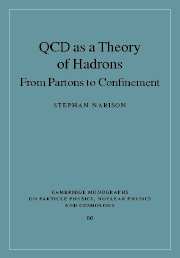Book contents
- Frontmatter
- Contents
- About Stephan Narison
- Outline of the book
- Preface
- Acknowledgements
- Part I General introduction
- Part II QCD gauge theory
- Part III MS-bar scheme for QCD and QED
- Part IV Deep inelastic scatterings at hadron colliders
- Part V Hard processes in e+e– collisions
- Part VI Summary of QCD tests and αs measurements
- Part VII Power corrections in QCD
- Part VIII QCD two-point functions
- Part IX QCD non-perturbative methods
- Part X QCD spectral sum rules
- 47 Introduction
- 48 Theoretical foundations
- 49 Survey of QCD spectral sum rules
- 50 Weinberg and DMO sum rules
- 51 The QCD coupling αs
- 52 The QCD condensates
- 53 Light and heavy quark masses, etc
- 54 Hadron spectroscopy
- 55 D, B and Bc exclusive weak decays
- 56 B0s-B̄0s Mixing, Kaon Cp Violation
- 57 Thermal behaviour of QCD
- 58 More on spectral sum rules
- Part XI Appendices
- Bibliography
- Index
52 - The QCD condensates
from Part X - QCD spectral sum rules
- Frontmatter
- Contents
- About Stephan Narison
- Outline of the book
- Preface
- Acknowledgements
- Part I General introduction
- Part II QCD gauge theory
- Part III MS-bar scheme for QCD and QED
- Part IV Deep inelastic scatterings at hadron colliders
- Part V Hard processes in e+e– collisions
- Part VI Summary of QCD tests and αs measurements
- Part VII Power corrections in QCD
- Part VIII QCD two-point functions
- Part IX QCD non-perturbative methods
- Part X QCD spectral sum rules
- 47 Introduction
- 48 Theoretical foundations
- 49 Survey of QCD spectral sum rules
- 50 Weinberg and DMO sum rules
- 51 The QCD coupling αs
- 52 The QCD condensates
- 53 Light and heavy quark masses, etc
- 54 Hadron spectroscopy
- 55 D, B and Bc exclusive weak decays
- 56 B0s-B̄0s Mixing, Kaon Cp Violation
- 57 Thermal behaviour of QCD
- 58 More on spectral sum rules
- Part XI Appendices
- Bibliography
- Index
Summary
We anticipated this discussion in Chapter 27 when we discussed the anatomy of the SVZ expansion. Here, we shall review the different determinations of the QCD condensates from QSSR.
Indeed, a good control of the values of the QCD condensates is necessary in the phenomenological applications of QSSR. The non-vanishing value of the light quark condensate, which we shall discuss in the next section, is intimately related to theGMORrealization of chiral symmetry, as can be inferred from the PCAC relation. SVZ [1,654] have also postulated that QCD is spontaneously broken by the gluon condensate, which they confirm from their analysis of the charmonium sum rule. The non-vanishing value of the gluon condensate and the gluon correlation length has been also checked on the lattice [402]. Since the pioneering work of SVZ, [1] a lot of effort has been devoted to this issue as can be found in the long list of published papers in this subject (for reviews see e.g. [3],[51,46], [356–363]). The condensates have been extracted from the light mesons [403–409], [325], [33,328], [341,387], and in [329] (Section 52.10), from the baryons [424–430], from the heavy quarkonia [433,434], and [313] (Section 51.3), and from the heavy-light mesons [401].
The e+e– →hadrons and τ-decays data have been always used as a laboratory for testing the perturbative and non-perturbative structure of QCD[1,3,325], [403–409], [346,338,341] and [329,161] (Sections 19.4 and 52.10).
- Type
- Chapter
- Information
- QCD as a Theory of HadronsFrom Partons to Confinement, pp. 550 - 571Publisher: Cambridge University PressPrint publication year: 2004



